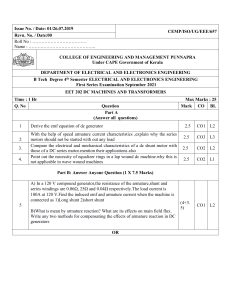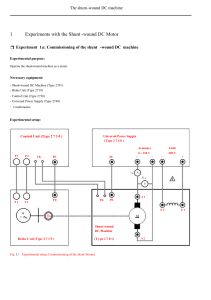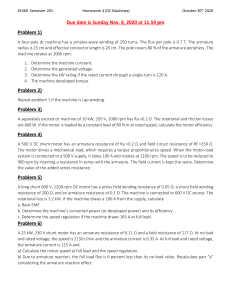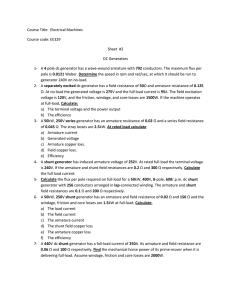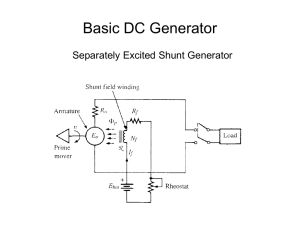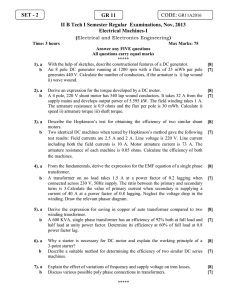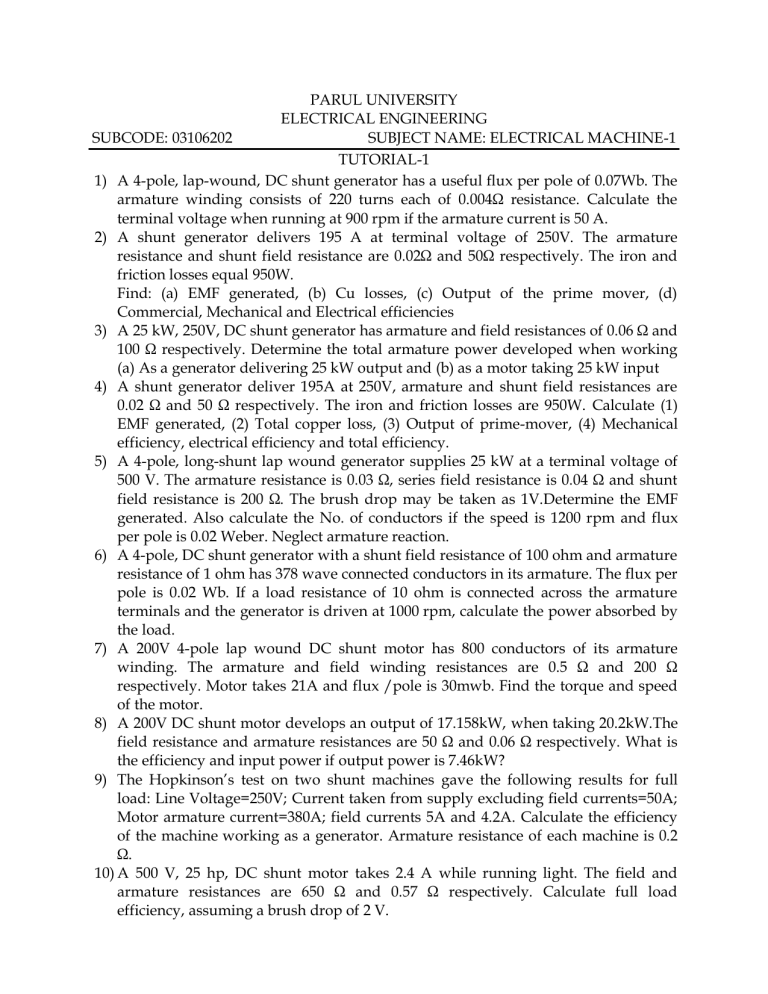
PARUL UNIVERSITY ELECTRICAL ENGINEERING SUBCODE: 03106202 SUBJECT NAME: ELECTRICAL MACHINE-1 TUTORIAL-1 1) A 4-pole, lap-wound, DC shunt generator has a useful flux per pole of 0.07Wb. The armature winding consists of 220 turns each of 0.004Ω resistance. Calculate the terminal voltage when running at 900 rpm if the armature current is 50 A. 2) A shunt generator delivers 195 A at terminal voltage of 250V. The armature resistance and shunt field resistance are 0.02Ω and 50Ω respectively. The iron and friction losses equal 950W. Find: (a) EMF generated, (b) Cu losses, (c) Output of the prime mover, (d) Commercial, Mechanical and Electrical efficiencies 3) A 25 kW, 250V, DC shunt generator has armature and field resistances of 0.06 Ω and 100 Ω respectively. Determine the total armature power developed when working (a) As a generator delivering 25 kW output and (b) as a motor taking 25 kW input 4) A shunt generator deliver 195A at 250V, armature and shunt field resistances are 0.02 Ω and 50 Ω respectively. The iron and friction losses are 950W. Calculate (1) EMF generated, (2) Total copper loss, (3) Output of prime-mover, (4) Mechanical efficiency, electrical efficiency and total efficiency. 5) A 4-pole, long-shunt lap wound generator supplies 25 kW at a terminal voltage of 500 V. The armature resistance is 0.03 Ω, series field resistance is 0.04 Ω and shunt field resistance is 200 Ω. The brush drop may be taken as 1V.Determine the EMF generated. Also calculate the No. of conductors if the speed is 1200 rpm and flux per pole is 0.02 Weber. Neglect armature reaction. 6) A 4-pole, DC shunt generator with a shunt field resistance of 100 ohm and armature resistance of 1 ohm has 378 wave connected conductors in its armature. The flux per pole is 0.02 Wb. If a load resistance of 10 ohm is connected across the armature terminals and the generator is driven at 1000 rpm, calculate the power absorbed by the load. 7) A 200V 4-pole lap wound DC shunt motor has 800 conductors of its armature winding. The armature and field winding resistances are 0.5 Ω and 200 Ω respectively. Motor takes 21A and flux /pole is 30mwb. Find the torque and speed of the motor. 8) A 200V DC shunt motor develops an output of 17.158kW, when taking 20.2kW.The field resistance and armature resistances are 50 Ω and 0.06 Ω respectively. What is the efficiency and input power if output power is 7.46kW? 9) The Hopkinson’s test on two shunt machines gave the following results for full load: Line Voltage=250V; Current taken from supply excluding field currents=50A; Motor armature current=380A; field currents 5A and 4.2A. Calculate the efficiency of the machine working as a generator. Armature resistance of each machine is 0.2 Ω. 10) A 500 V, 25 hp, DC shunt motor takes 2.4 A while running light. The field and armature resistances are 650 Ω and 0.57 Ω respectively. Calculate full load efficiency, assuming a brush drop of 2 V. 11) A DC shunt machine when run as a motor on no-load takes 440w at 220V and runs at 1000rpm. The field current and armature resistance are 1A and 0.5 Ω respectively. Calculate the efficiency of the machine when running (1) As a generator delivering 40A at 220V, (2) As a motor taking 40A from a 220 supply. 12) A 240V DC shunt motor has an armature resistance of 0.4 ohm and is running at the full-load speed of 600 rpm with a full load current of 25A. The field current is constant; also a resistance of 1 ohm is added in series with the armature. Find the speed (i) at the full-load torque and (ii) at twice the full-load torque

